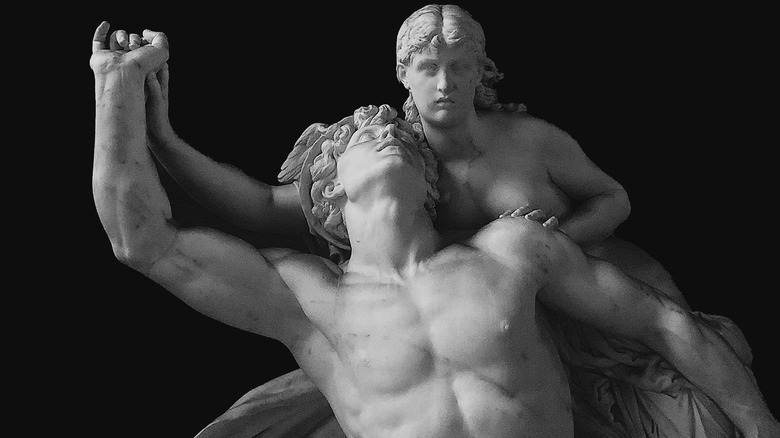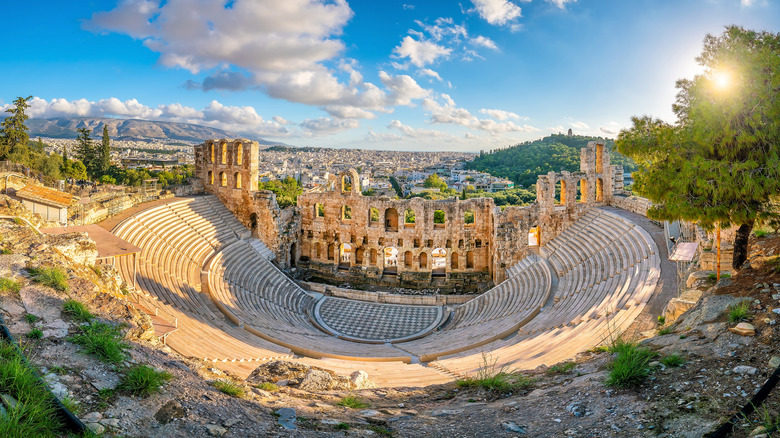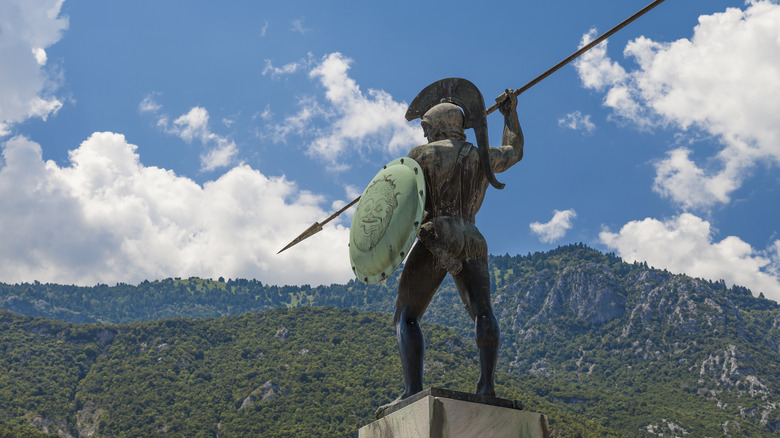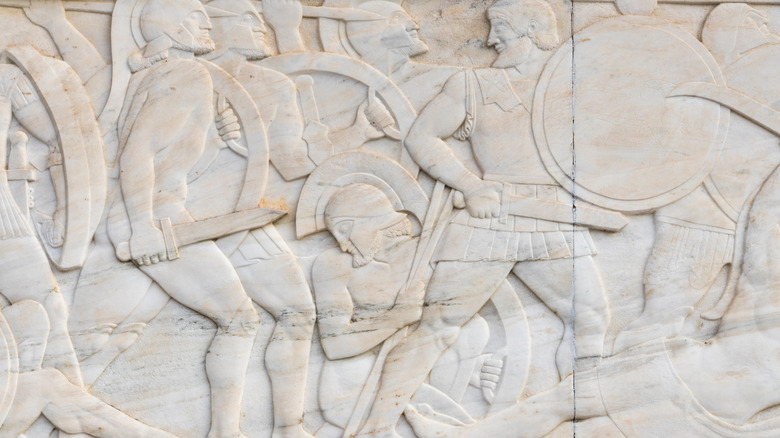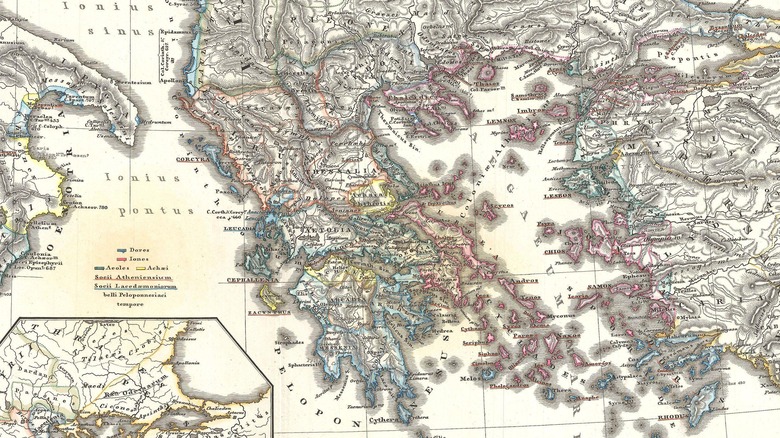The Rivalry Between Ancient Athens And Sparta Explained
The jock and the nerd: it's a tale as old as time. Who isn't familiar with those ancient Greek tales about burly, helmeted Spartans shoving those prissy, toga-wearing Athenians and their scrolls into lockers at school? And then an Athenian whiz kid blows away some Spartan dumb-dumbs during a class debate, and the Spartans hurl over the debate table and tackle the Athenian kid and get detention. And then the one Athenian who made varsity football stages a clever locker room revenge prank in honor of the god of wild abandon, Dionysus, involving diluted wine in the showers and false prophecies intoned over fake pig entrails. And ... hang on, are we getting some things mixed up here? Kind of.
Yes, Athens vs. Sparta really is the most infamous rivalry of the ancient Greek world. Was their rivalry as petty as the above-described high school bullying and shenanigans stereotype? No, but it was definitely full of stubborn pride. Was it as simple as intellectuals vs. non-intellectuals? Somewhat, but it was more about territorial dominance and fundamentally opposed cultural ideologies, as the Constitutional Rights Foundation describes. Eventually, the rivalry culminated in the protracted, embittered, 56-year-long Peloponnesian War that ended ancient Greece's Golden Age, as the World History Encyclopedia explains. In the end, the conflict between the city-states of ancient Athens and Sparta was like the clash of siblings too different to get over their differences, and too paranoid about the strengths of the other to live in peace.
Athenian art, philosophy, and democracy
Ancient Athens gets credited with a lot, and rightfully so. Starting with the early reforms of the Athenian statesman Solon in 594 B.C.E., Athens created the world's first democratic government in any recognizable form, as Classics Teacher describes. Athens is considered the birthplace of Western philosophical inquiry via intellectual titans like Socrates, Aristotle, and Plato, as Students of History overviews. Athens gifted us the art form of theater and stagecraft via playwrights like Euripides, Sophocles, Aeschylus, and more, as the Canadian Museum of History explains. In short, it's easy to envision Athens — most especially it's Golden Age in the 5th century B.C.E. — as a place of refined culture, societal progressivism, and high education.
Such accomplishments didn't come easily or overnight. Athenian life was consumed by an obligation to one's polis: the place where one lived, and the collective body of people with whom one lived, per Wondrium Daily. Tales of Times Forgotten describes how civic life was mandatory for all eligible citizens, to the point where it was a crime to not participate. The organization of government, viewable in flowchart form on Classic Teachers, shows immense complexity and pointedness behind each piece of government. Every citizen had a distinct role, including duties defined by gender, all in the interest of fostering free and open public discussion and debate. Athens was also a city built for beauty, down to the buildings, and a center for maritime trade, as the Constitutional Rights Foundation explains.
Spartan militarism, fitness, and oligarchy
In contrast to Athens, there couldn't be a city-state more different than Sparta. Sparta was a warrior society ruled by a dual-king military autocracy. In fact, as the Constitutional Rights Foundation explains, Sparta was so obsessively militaristic that all Spartan men had one job, and one job only: soldier. While unfit babies were left exposed to the elements to die, healthy boys lived in barracks with other men from the age of 7 all the way to 30. Only then were they allowed to get married, and afterward remained soldiers until the age of 60. Women underwent extensive physical training, too, but for the express purpose of producing strong warriors. All other work in Spartan society was done by slaves. As World History Encyclopedia says, education in Sparta amounted to military training and teaching loyalty to one's "brothers-in-arms."
Classics Teacher has a flowchart of the Spartan government, a government just as no-frills as Spartan society. As the Metropolitan Museum of Art describes, Spartan life all but dispensed with artistic ventures and philosophical inquiry entirely, much like our modern adjective "Spartan" implies. Sparta was also a land-locked agricultural society that subsisted on tourism and conquering others to grow their economy (per Diffen and Pediaa, respectively). They mistrusted non-Spartans, no thanks in small part due to a Messenian slave uprising in 650 B.C.E., as the Constitutional Rights Foundation explains. They also, fatefully so, had no navy and relied on other city-states like Athens to keep trade routes free.
United against the Persian Empire
Even only judging by the above descriptions, it's not hard to see why folks from Athens and Sparta didn't see eye to eye. Everything from simple conversations about food seasoning to discussions about handling crises would have likely involved a lot of talking past each other. The staggering differences between Athenian and Spartan life also demonstrate, inherently, why these two city-states in particular — not Corinth, Thebes, Rhodes, Syracuse, etc. — butted heads. Yes, they were both Greek in a general sense, and they spoke the same language. But like the difference between Nashville and Seattle in the U.S., for instance, or London and Newcastle in England, sharing the same land and overall identity doesn't mean that folks feel unified.
For a time there was unity in ancient Greece, but only in the face of a common foe: the Persian Empire. As World History Encyclopedia describes, Sparta and Athens banded together with other city-states to fight off Persian invasions in 490 and 480 B.C.E. by kings Darius and Xerxes, respectively, just when Athens was entering its Golden Age. Eventually, through a combination of Spartan land power at the battle of Thermopylae — glorified in films like 2006's "300" — and Athenian naval power in the following battle of Salamis, the Greeks protected their civilization. But as soon as they defeated the Persians, power shifted within Greek city-states. The rivalry between Sparta and Athens redoubled, and Greece devoured itself from within.
The rise of the Delian League
Before the Persian Empire invaded, Sparta stood at the forefront of Greek city-states. As World History Encyclopedia explains, Sparta formed the Peloponnesian League — a confederation of allied city-states in 550 B.C.E. — to solidify its power. Geography was critical to this decision, as Sparta is located on the Peloponnesus, a large, jutting landmass in the south of Greece that connects to the mainland only through a narrow isthmus occupied by Corinth. This meant that Sparta was locked in competition against regional Peloponnesian neighbors like Argos, and also had to collaborate eastward for trade purposes. But after Sparta and Athens reached across the aisle during the Persian Wars, Athens rose to prominence and Sparta grew nervous.
Within two years of the Persian Wars ending, Athens formed its own league in 478 B.C.E.: the Delian League. As Brown University explains, the ostensible purpose of the league was protection from invaders. Some have argued, though, that the Athenians were just as nervous about Spartan power as the Spartans were about them, and that the Delian League was just a way to strengthen themselves against Spartan might. Both city-states grew increasingly powerful through their respective taxes: soldiers for the militant Spartans and money for the democratic Athenians. This was precisely when Athens entered its Golden Age and the height of its art and culture, per Students of History. Such resplendence wouldn't last long, though. In less than 20 years, in 460 B.C.E., Sparta attacked.
Devoured from within
As World History Encyclopedia explains, the Athenian Delian League encircled the Aegean Sea and included city-states along the western border of Asia Minor, modern-day Turkey. This facilitated trade and enriched Athens, which appeared threatening to Sparta, as the University of Cambridge says. Athens also wanted territorial expansion, while Sparta, which saw itself as the true defender of Greece, wanted to maintain the status quo. In the end, Athens and Sparta got locked into a relationship characterized by miscommunication, mistrust, and an utter mismatch of values. A cultural rift evolved into all-out war.
The Spartan and Athenian Peloponnesian War lasted from 460 to 404 B.C.E., per World History Encyclopedia. Combat came in waves and battles raged. Allegiances and alliances rose and fell year by year. Relationships between Greek city-states deteriorated, and Rhodes turned on Athens in 412 B.C.E. Hatreds grew so deep that Sparta — defenders against the Persians at the legendary battle of Thermopylae — made a pact with the Persians against Athens that same year. The Persians would get Asia Minor, including the Delian League cities there, and gain dominance across the Aegean. By 404 B.C.E. Athens was done and the Greek Golden Age was over.
In a further tragic twist, Sparta's own actions destroyed itself. In the wake of Athenian defeat, Sparta grew ambitious and domineering. Its neighbors turned on it, as World History Encyclopedia says, and cities like Thebes beat Sparta back. By 366 B.C.E. the Spartan Peloponnesian League, and Sparta itself, was finished.
